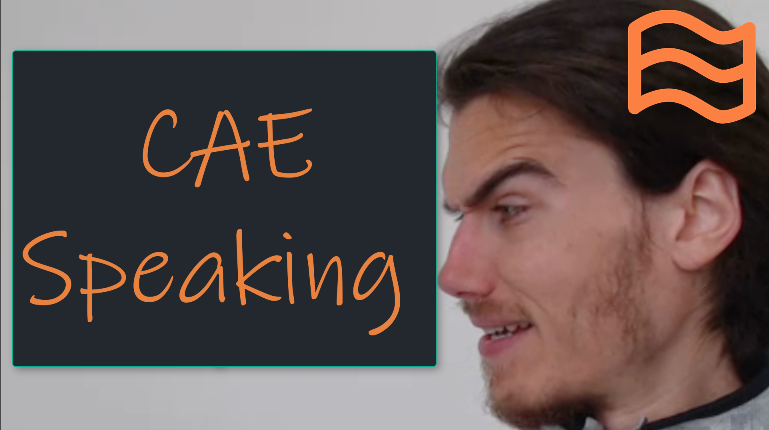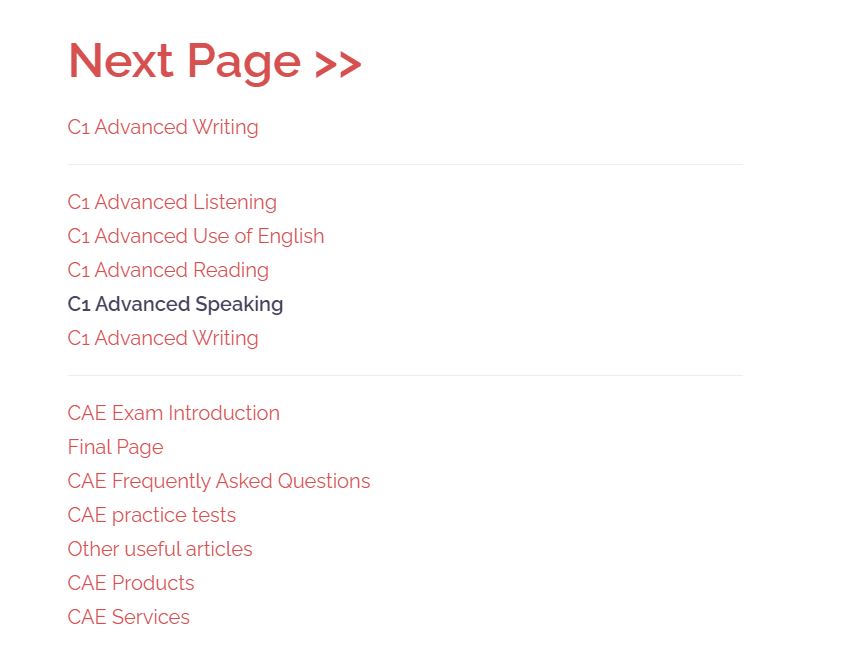Table of Contents
CAE Speaking Test Tips And Technique Introduction
Are you nervous about the speaking part of the CAE exam? If the answer is 'yyyyyyeeeeesssss!!!!!' then, don't worry, you are not alone. Speaking in an exam scenario can be daunting, even more so in a different language, but there are techniques you can use to make it easier and more relaxing. This CAE Speaking test tips page will hopefully give you some really useful advice for the C1 Advanced speaking paper, so let's get started...
CAE Speaking Test Format
The 'Speaking' section has 4 parts. The length of this section depends on how many candidates there are. Normally 2 candidates take the test together and this lasts approximately 15 minutes. Occasionally 3 candidates take the test together and then each part is slightly longer.
The speaking section assesses not only your knowledge and use of language, but also your ability to interact and have a conversation with the other candidate(s). You should try to give long responses to questions, justifying what you say. This way you will show a wider range of language ability. The more you speak the more language you can show. I often tell my students to think 'why am I saying this' or 'Why did I make that comment'. You should then try to answer these questions while you are speaking. 'I'm saying this because...' 'I made that comment because...'
CAE Speaking Test Marking Criteria
Here is a video explaining how your speaking test is marked:
CAE Speaking Test Part 1
In the 'Speaking' section part 1, you have to answer some general questions about your personality, what you do etc. Here are some example questions:
How long have you been studying English?
What do you think you'll be doing in five years time?
Do you enjoy travelling?
Tips and Technique
Look at the questions above. Think of your own questions you would ask someone you've just met for example. Think about what general questions you might be asked in an interview type situation.
Write down some lengthy answers to these questions. You may need to use one in the exam!
Practise answering these questions with somebody you know. If they're English – even better! Get them to give you feedback and think how you can make the answers longer or better.
CAE Speaking Test Part 1 Examples
Here are some example questions and answers for Part 1:
Question
- Where are you from?
Potential Answer
I'm from Madrid, Spain.
Or
I'm from a busy/lively/bustling area(/erea/) / place.
Question
- What do you do?
Potential Answer
I've been living in London for three years, working as a primary school teacher in different schools. I mainly work with children in Reception, their first year of school. I've really enjoyed the experience and found it invaluable. I've now moved back to my home country where, hopefully, I'll be able to find a good/suitable position as a teacher.
Question
- How long have you been studying English?
Potential Answer
I've been exposed to the English language since I was a child even though I lived in Spain because it was something I always showed a special interest in. I've been studying English properly since secondary school and I went on to study an English teaching degree at university in Madrid. I've been living in England for the last 3 years, so I've had the opportunity of being in an English speaking environment.
Question
- What do you enjoy most about learning English?
Potential Answer
I personally find it essential in order to move up the career ladder and carry out my job properly. I also find learning English really useful because it offers you the opportunity to communicate with people in most parts of the world which makes travelling a lot easier. This is, in my view, one of the main advantages of learning English.
Check out my long CAE course for more part 1 information and exercises.
CAE Speaking Test Part 2
In the 'Speaking' section part 2, the examiner gives you 3 pictures. The examiner will ask you to compare the pictures and will normally give you two questions to answer. Individually, you talk about two of the three pictures for 1 minute. After the other candidate speaks, you also have 30 seconds to answer a question about their pictures.
Tips and Technique
Don't describe what you see in the picture. This is not what the examiner wants. Also, 1 minute is not long, so you cannot waste any time.
Try to compare the photographs as much as you can while answering the questions. Look at the first question, answer this about the first picture you choose, then answer the same question for the second picture. Look at the second question and do the same thing. Then go back to the first question and try to think of another point to say about the first picture and then the second picture etc.
You need to be careful not to spend too much time talking about one picture, so this method should help.
Think about some general topics beforehand which can apply to lots of photographs in different situations. Some ideas are the advantages and disadvantages surrounding: expense, social life, indoor/outdoor activities.
You should practise this before the exam. This will help you with the technique and give you more confidence. Practising will also give you a better idea how long you need to talk for. You can do this in your free time with a friend/colleague etc. Get 3 random photographs and think of two questions to answer about them. Then try to answer both questions while comparing 2 of the pictures. Time yourself so you don't speak for more than one minute.
There are more part 2 exercises in my long CAE course >>
CAE Speaking Test Part 3
In the 'Speaking' section part 3, you have a question to discuss with the other candidate(s). The exercise takes the form of a spider diagram. The question is in the middle of a sheet of paper and it has some ideas connected to it. You don't need to discuss all of these ideas while answering the question. If there are 2 candidates you have 2 minutes, if there are 3 candidates you have 3 minutes. The examiner then asks you another question related to the topic. The question will require you to come to some sort of decision. You do not have to agree with your partner.
Tips and Technique
You don't have to discuss all of the points, but you should try to discuss two or three in detail. If you aim to discuss three points you can show more language ability. I advise you to state what you think about an idea and then give a reason for this. Then ask your partner for his/her opinion. This is simple and it could lead to further discussion depending on if you agree or disagree with your partner.
Some useful questions to ask your partner are: 'do you agree with me?' 'what's your opinion?'
Some useful phrases to agree or disagree with your partner are: 'I see what you're saying, but I think...' 'hmm, I'm not sure I agree with you on that point...'
When your partner stops speaking, if you have nothing more to contribute, you should move on to the next idea. Some useful phrases for this are: 'let's look at …..' 'why don't we talk about....'
There are more part 3 exercises in my long CAE course >>
CAE Speaking Test Part 4
In the 'Speaking' section part 4, you have to answer questions from the examiner based on the topic from part 3. You should respond to the examiner and to what your partner says.
Tips and Technique
For this section it is again important to develop full and coherent answers. It is also important to practise agreeing or disagreeing with other people in a conversation. Think of a global or important everyday issue and write down some questions related to this topic. Practise answering these questions with someone you know.
Remember to say why you think something. 'I think laptops and tablets are bad because....'
Question: 'do you think the working week should be made longer or shorter?'
Answer: 'I don't think the working week should be made longer....'
why?
Reason for answer: '...because, in my opinion people don't have enough free time to enjoy fun activities with their families and friends.'
Your opinions are not really important. How you express yourself through language and the structure of your answers are important.
When practising, ask your partner to give some different opinions about the same idea. Then you can practise both agreeing and disagreeing with what they say. Always state why you agree/disagree. 'I completely agree with you because....' or 'I'm sorry, I don't agree with that at all, because....'
You can also find more useful tips and techniques on this page.
There are more part 4 exercises in my long CAE course >>
Prepare for C1 Advanced Online
My aim is to help you to pass the CAE. Nevertheless, it is very difficult to achieve this without having some professional help. Therefore, while most information I provide is free, I do recommend that you book some lessons and it might be worth reading this page to learn how best to prepare for the CAE online by yourself.



